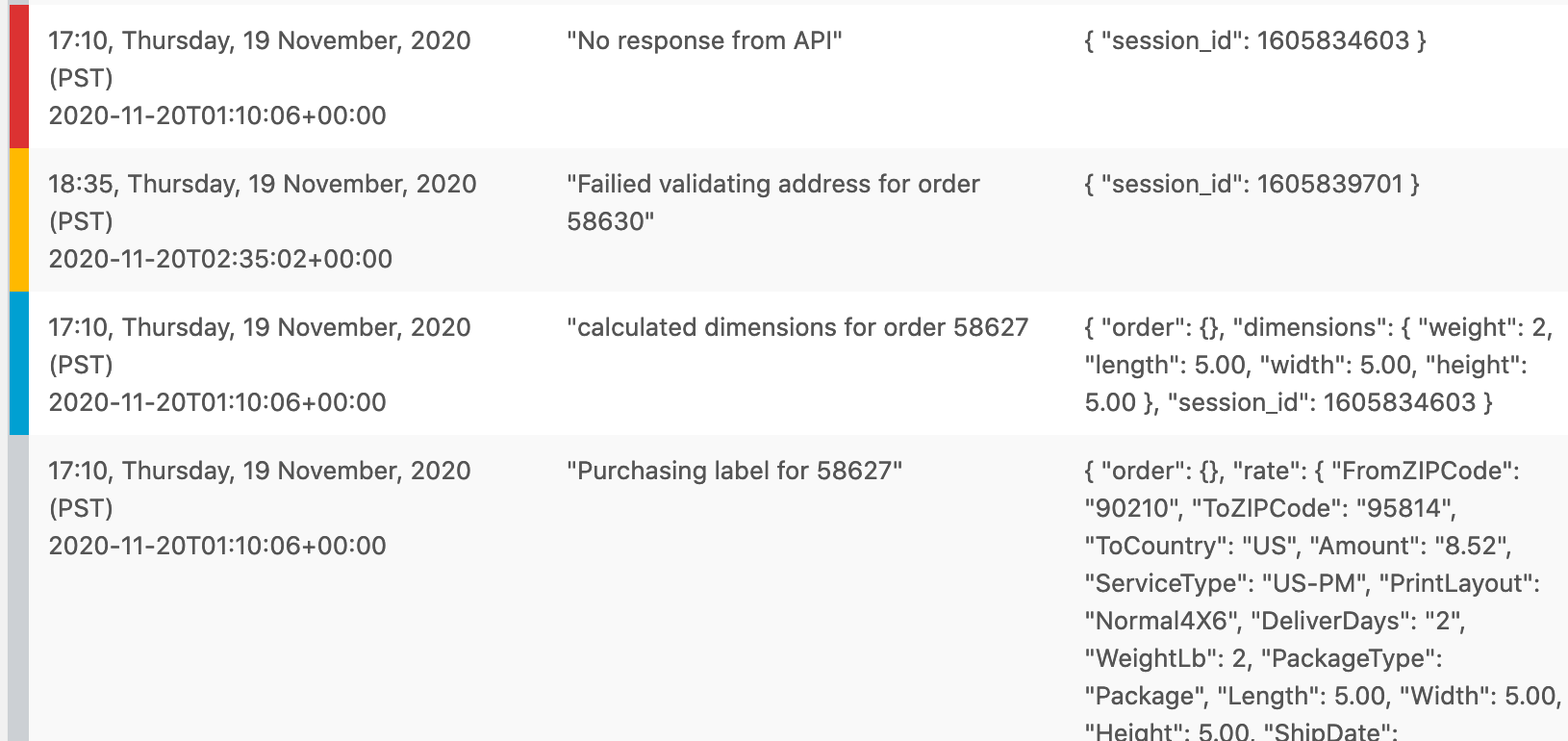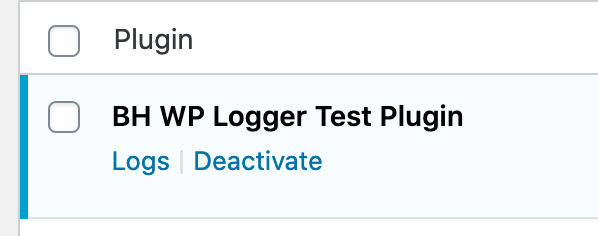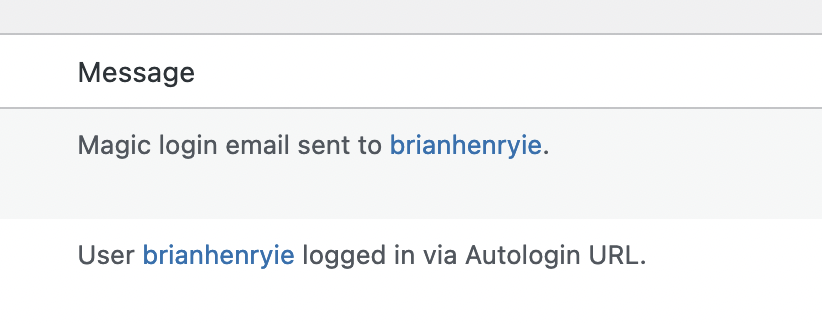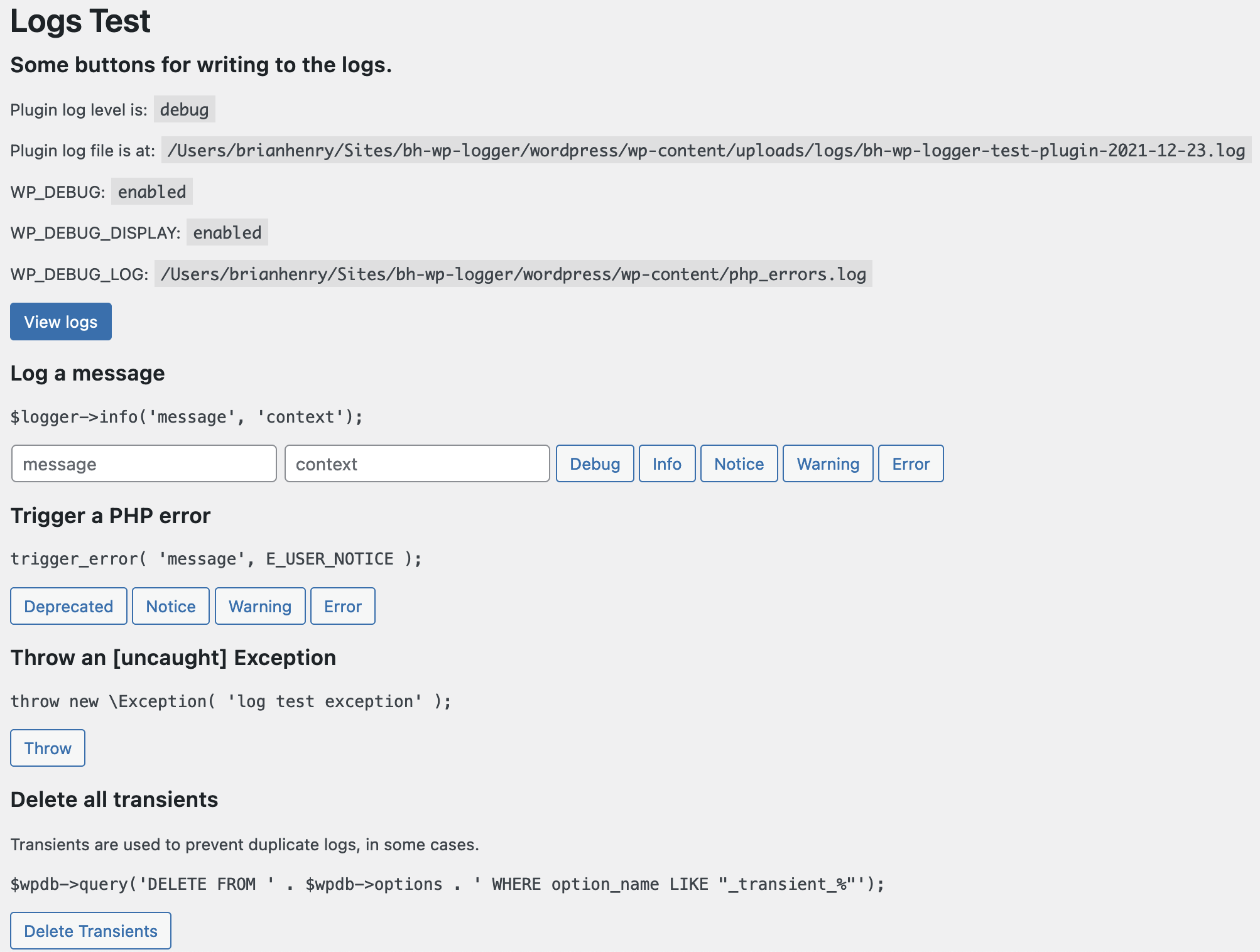brianhenryie / bh-wp-logger
WordPress 插件的 PSR 日志记录器,拥有友好的 WP_List_Table 用户界面。
Requires
- php: >=7.4
- ext-json: *
- brianhenryie/bh-wc-logger: ^0.1.0
- brianhenryie/bh-wp-cli-logger: ^1.0
- brianhenryie/bh-wp-private-uploads: ^0.1.1
- katzgrau/klogger: dev-master
- psr/log: ^1.0
- wptrt/admin-notices: ^1.0
Requires (Dev)
- 10up/wp_mock: ^1.0
- alleyinteractive/wordpress-autoloader: ^1.1
- antecedent/patchwork: ^2.1
- brianhenryie/color-logger: ^1.0
- codeception/module-asserts: *
- codeception/module-cli: *
- codeception/module-db: *
- codeception/module-filesystem: *
- codeception/module-phpbrowser: *
- codeception/module-webdriver: *
- codeception/util-universalframework: *
- cweagans/composer-patches: *
- jaschilz/php-coverage-badger: ^2.0
- kporras07/composer-symlinks: dev-master
- lucatume/wp-browser: ^3.0
- php-stubs/woocommerce-stubs: *
- phpcompatibility/phpcompatibility-wp: *
- phpstan/extension-installer: *
- phpunit/phpcov: *
- squizlabs/php_codesniffer: ^3.7
- szepeviktor/phpstan-wordpress: ^1.3
- woocommerce/woocommerce-sniffs: *
- wordpress/wordpress: *
- wp-cli/wp-cli-bundle: *
- wp-coding-standards/wpcs: ^3.0
- wpackagist-plugin/woocommerce: *
- wpackagist-theme/twentytwenty: *
This package is auto-updated.
Last update: 2024-09-08 23:41:04 UTC
README
BH WP Logger
WordPress 插件的零配置日志记录器用户界面。
$logger = Logger::instance();
封装现有的 PSR-3 日志记录器并添加一些用户界面。
默认使用 KLogger,指定时使用 WC_Logger,当日志级别设置为 "none" 时使用 NullLogger。
使用 PHP 的 set_error_handler() 捕获 PHP 弃用/warning/notice/错误。
钩入 WordPress 的弃用函数钩子(例如 deprecated_function_run 等),只记录每天一次。
使用 PHP 的 register_shutdown_function() 捕获与插件相关的异常。
在 cron 中删除 30 天前的日志文件。
在错误时记录完整的堆栈跟踪。当级别为调试时,在每次日志中记录两个步骤的堆栈跟踪。
用户界面
在 WP_List_Table 中显示日志。
每次有新错误时,显示可关闭的管理员错误通知。
在 plugins.php 中的插件条目上添加日志查看链接。
当日志消息包含 `wp_user:123`(注意:由单引号包围)时,它将被替换为用户资料的链接。这允许在不记录 PII 的情况下记录对用户的引用。
类似地,任何帖子类型都可以通过 `post_type_name:123`(例如 `shop_order:123` 将链接到 WooCommerce 订单)链接。
使用
Composer
composer require brianhenryie/bh-wp-logger
直到 v1.0.0 版本,每次发布都可能有破坏性的变化。
实例化
您应该使用 brianhenryie/strauss 来前缀库的命名空间。然后 Strauss 的自动加载器会为您包括文件。
以下将生效,但提供设置会更快、更可靠
$logger = Logger::instance();
提供设置
$logger_settings = new class() implements BrianHenryIE\WP_Logger\API\Logger_Settings_Interface { use BrianHenryIE\WP_Logger\Logger_Settings_Trait; public function get_log_level(): string { return LogLevel::INFO; } // This is used in admin notices. public function get_plugin_name(): string { return "My Plugin Name"; } // This is used in option names and URLs. public function get_plugin_slug(): string { return "my-plugin-name"; } // This is needed for the plugins.php logs link. public function get_plugin_basename(): string { return "my-plugin-name/my-plugin-name.php"; } }; $logger = Logger::instance( $logger_settings );
然后传递您的 $logger 实例。
一旦实例化了日志记录器,后续对 ::instance() 的调用将返回现有实例,并且忽略任何传递的 $logger_settings。
要使用 WooCommerce 的原生 WC_Logger,在设置对象上使用 WooCommerce_Logger_Interface 接口(它仅扩展 Logger_Settings_Interface)。
$logger_settings = new class() implements BrianHenryIE\WP_Logger\WooCommerce\WooCommerce_Logger_Settings_Interface { ...
WooCommerce 设置
以下内容可以用于 WooCommerce 设置 API。
$log_levels = array( 'none', LogLevel::ERROR, LogLevel::WARNING, LogLevel::NOTICE, LogLevel::INFO, LogLevel::DEBUG ); $log_levels_option = array(); foreach ( $log_levels as $log_level ) { $log_levels_option[ $log_level ] = ucfirst( $log_level ); } $setting_fields[] = array( 'title' => __( 'Log Level', 'text-domain' ), 'label' => __( 'Enable Logging', 'text-domain' ), 'type' => 'select', 'options' => $log_levels_option, 'desc' => __( 'Increasingly detailed levels of logs. ', 'text-domain' ) . '<a href="' . admin_url( 'admin.php?page=plugin-slug-logs' ) . '">View Logs</a>', 'desc_tip' => false, 'default' => 'notice', 'id' => 'text-domain-log-level', );
过滤器
有两个过滤器,用于在保存日志数据时修改日志数据,以及在呈现日志数据时修改日志数据。
例如,更改特定日志消息的日志级别
/** * Modify the log data array or return null to cancel logging this entry. * The library php-http/logger-plugin is using INFO for detailed logging, let's change that to DEBUG. * * @hooked {$plugin_slug}_bh_wp_logger_log * * @pararm array{level:string,message:string,context:array} $log_data * @param Logger_Settings_Interface $settings * @param BH_WP_PSR_Logger $bh_wp_psr_logger */ function modify_log_data( array $log_data, \BrianHenryIE\WP_Logger\Logger_Settings_Interface $settings, \BrianHenryIE\WP_Logger\API\BH_WP_PSR_Logger $bh_wp_psr_logger): ?array { if ( 0 === strpos( $log_data['message'], 'Sending request' ) ) { $log_data['level'] = LogLevel::DEBUG; } return $log_data; } add_filter( "{$plugin_slug}_bh_wp_logger_log", 'modify_log_data', 10, 3 );
例如,在日志表显示时将日志中的文本转换为超链接
/** * Update ` `wc_order:123` ` with links to the order. * Use preg_replace_callback to find and replace all instances in the string. * * @hooked {$plugin_slug}_bh_wp_logger_column * * @param string $column_output The column output so far. * @param array{time:string, level:string, message:string, context:array} $item The log entry row. * @param string $column_name The current column name. * @param Logger_Settings_Interface $logger_settings The logger settings. * @param BH_WP_PSR_Logger $bh_wp_psr_logger The logger API instance. * * @return string */ function replace_wc_order_id_with_link( string $column_output, array $item, string $column_name,\BrianHenryIE\WP_Logger\Logger_Settings_Interface $logger_settings, \BrianHenryIE\WP_Logger\API\BH_WP_PSR_Logger $bh_wp_psr_logger ): string { if ( 'message' !== $column_name ) { return $column_output; } $callback = function( array $matches ): string { $url = admin_url( "post.php?post={$matches[1]}&action=edit" ); $link = "<a href=\"{$url}\">Order {$matches[1]}</a>"; return $link; }; $message = preg_replace_callback( '/`wc_order:(\d+)`/', $callback, $column_output ) ?? $column_output; return $message; } add_filter( "{$plugin_slug}_bh_wp_logger_column", 'replace_wc_order_id_with_link', 10, 5 );
WP_Mock
如果您使用 WP_Mock 进行测试,并且您正在实例化此日志记录器,以下内容可能会有所帮助
\Patchwork\redefine( array( Logger::class, '__construct' ), function( $settings ) {} );
测试插件
test-plugin 文件夹包含一个小的插件,其中包含按钮来触发可以记录的错误类型。
最佳实践
根据我有限的日志记录经验,我在函数开始时添加一个 debug 日志,并在函数返回时添加适当的 info...error。
TODO
检查日志目录不是公开可访问的- 检查上传目录的 chmod(可写)。=> 查看 brianhenryie/bh-wp-private-uploads
- 将当前用户添加到上下文
不要记录空上下文(WC)- 显示管理员通知的错误的级别选项
- 显示管理员通知的用户能力选项(过滤器,至少)
零配置 WC_Logger:检测插件名称中的 "wc"、"woo"。在上下文 json 中使用 代码美化工具: 已使用 caldwell/renderjson- 分页和过滤
消息中的超链接记录上次查看日志的时间戳,如果有新的日志,将 plugins.php 链接加粗。自动删除旧日志当访问日志页面时,日志通知应消失删除敏感数据。例如,在保存的日志中使用userid:123,并在显示时用更丰富的数据替换它- 将错误添加到仪表板站点健康小部件
- 确保输出被正确转义
一些小问题
- 调试日志可能可以移动到关闭处理程序
- 用于抑制重复日志的转瞬即逝可能不够高效
状态
到目前为止,我认为它主要是由我使用的,即内部项目。没有严重问题。它应该对每个人都适用,但我希望从其他人那里得到一些反馈,看看它对你来说效果如何。
一旦我追上了 WPCS、PhpStan 和 PhpUnit,我就会从 Semver 1.0.0 开始。大约有 65 个测试和 43% 的覆盖率。WPCS + PHPStan 都相当不错。
我认为这比大多数 WordPress 插件的代码质量都要高。






